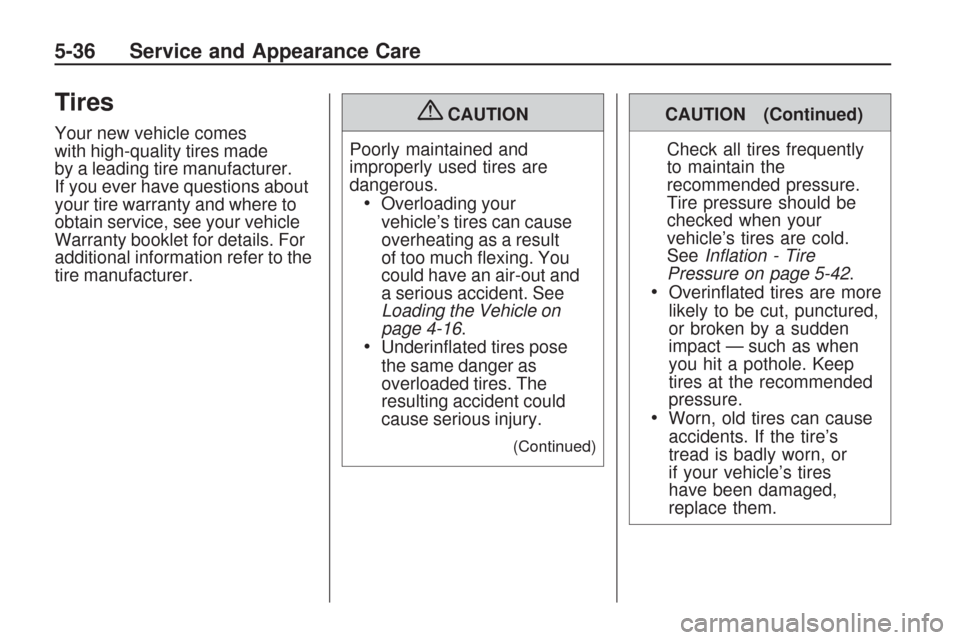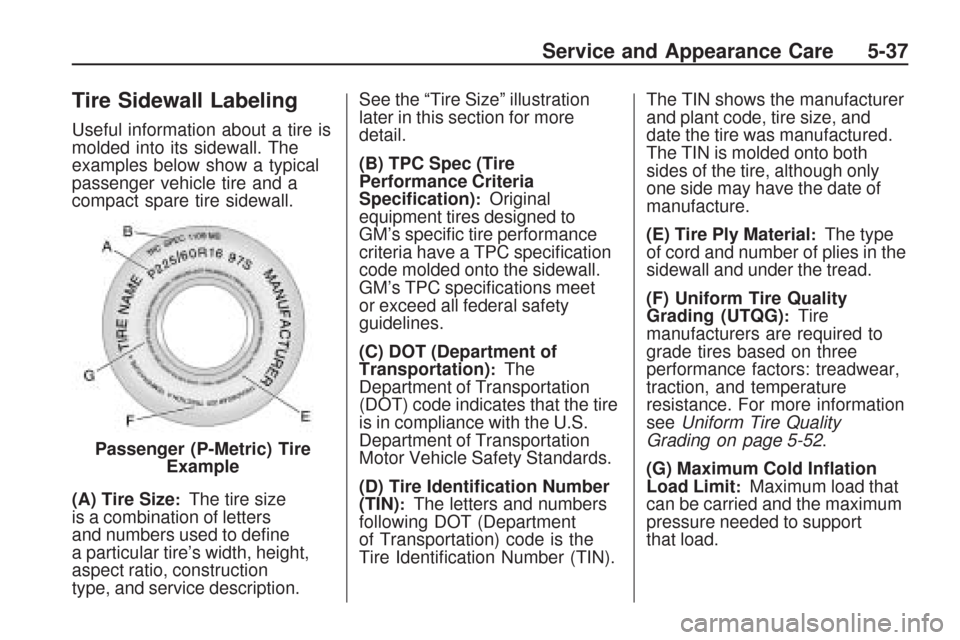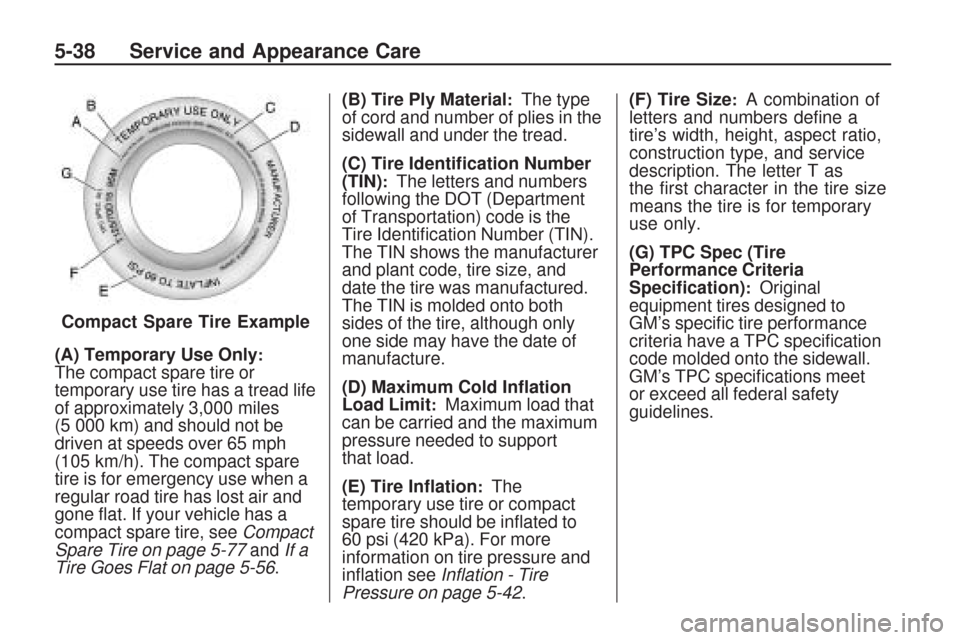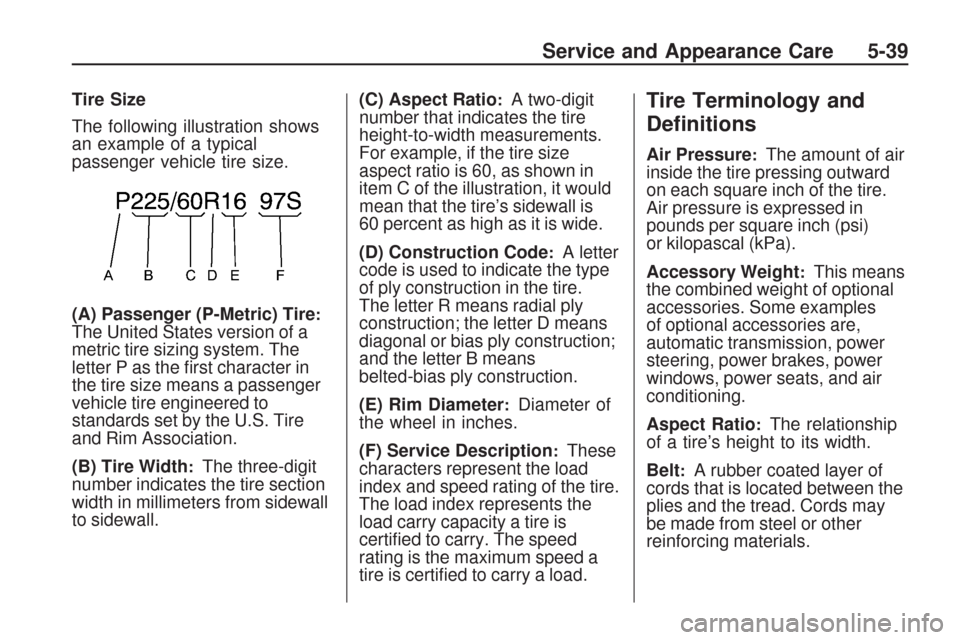2009 CHEVROLET TRAVERSE tire pressure
[x] Cancel search: tire pressurePage 252 of 422

And, of course, actual stopping
distances vary greatly with the
surface of the road, whether it is
pavement or gravel; the condition of
the road, whether it is wet, dry, or icy;
tire tread; the condition of the brakes;
the weight of the vehicle; and the
amount of brake force applied.
Avoid needless heavy braking. Some
people drive in spurts — heavy
acceleration followed by heavy
braking — rather than keeping pace
with traffic. This is a mistake. The
brakes might not have time to cool
between hard stops. The brakes will
wear out much faster with a lot of
heavy braking. Keeping pace with
the traffic and allowing realistic
following distances eliminates a lot of
unnecessary braking. That means
better braking and longer brake life.
If the engine ever stops while
the vehicle is being driven, brake
normally but do not pump the brakes.
If the brakes are pumped, the
pedal could get harder to push down.If the engine stops, there will still be
some power brake assist but it will
be used when the brake is applied.
Once the power assist is used up, it
can take longer to stop and the brake
pedal will be harder to push.
Adding non-dealer/non-retailer
accessories can affect vehicle
performance. SeeAccessories and
Modifications on page 5-3.
Antilock Brake
System (ABS)
This vehicle has the Antilock
Brake System (ABS), an advanced
electronic braking system that helps
prevent a braking skid.
When the engine is started and the
vehicle begins to drive away, ABS
checks itself. A momentary motor or
clicking noise might be heard while
this test is going on, and it might
even be noticed that the brake pedal
moves a little. This is normal.If there is a problem with ABS, this
warning light stays on. SeeAntilock
Brake System (ABS) Warning Light
on page 3-37.
Let us say the road is wet and you
are driving safely. Suddenly, an
animal jumps out in front of you.
You slam on the brakes and continue
braking. Here is what happens
with ABS:
A computer senses that the wheels
are slowing down. If one of the
wheels is about to stop rolling, the
computer will separately work
the brakes at each wheel.
ABS can change the brake pressure
to each wheel, as required, faster
than any driver could. This can help
the driver steer around the obstacle
while braking hard.
4-4 Driving Your Vehicle
Page 260 of 422

Hydroplaning
Hydroplaning is dangerous. Water
can build up under your vehicle’s
tires so they actually ride on the
water. This can happen if the road
is wet enough and you are going
fast enough. When your vehicle is
hydroplaning, it has little or no
contact with the road.
There is no hard and fast rule
about hydroplaning. The best
advice is to slow down when the
road is wet.
Other Rainy Weather Tips
Besides slowing down, other wet
weather driving tips include:
Allow extra following distance.
Pass with caution.
Keep windshield wiping
equipment in good shape.
Keep the windshield washer �uid
reservoir �lled.
Have good tires with proper
tread depth. SeeTires on
page 5-36.
Turn off cruise control.
Before Leaving on a
Long Trip
To prepare your vehicle for a long
trip, consider having it serviced by
your dealer/retailer before departing.
Things to check on your own include:
Windshield Washer Fluid:
Reservoir full? Windows
clean — inside and outside?
Wiper Blades:In good shape?
Fuel, Engine Oil, Other Fluids:All
levels checked?
Lamps:Do they all work and are
lenses clean?
Tires:Are treads good? Are tires
in�ated to recommended
pressure?
Weather and Maps:Safe to
travel? Have up-to-date maps?
4-12 Driving Your Vehicle
Page 265 of 422

{CAUTION
Do not load the vehicle any
heavier than the Gross Vehicle
Weight Rating (GVWR), or
either the maximum front or
rear Gross Axle Weight Rating
(GAWR). If you do, parts on
the vehicle can break, and it
can change the way your
vehicle handles. These could
cause you to lose control and
crash. Also, overloading can
shorten the life of the vehicle.Tire and Loading Information
Label
A vehicle speci�c Tire
and Loading Information
label is attached to the center
pillar (B-pillar) of your vehicle.
With the driver’s door open, you
will �nd the label attached below
the door lock post (striker).The tire and loading information
label shows the number of
occupant seating positions (A),
and the maximum vehicle
capacity weight (B) in kilograms
and pounds.
The Tire and Loading Information
label also shows the size of the
original equipment tires (C) and
the recommended cold tire
in�ation pressures (D). For more
information on tires and in�ation
seeTires on page 5-36and
Inflation - Tire Pressure on
page 5-42.
There is also important loading
information on the vehicle
Certi�cation/Tire label. It tells
you the Gross Vehicle Weight
Rating (GVWR) and the Gross
Axle Weight Rating (GAWR) for
the front and rear axle. See
“Certi�cation/Tire Label” later
in this section.
Example Label
Driving Your Vehicle 4-17
Page 283 of 422

Service and
Appearance Care
ServiceService................................5-3
Accessories and
Modi�cations.......................5-3
California Proposition 65
Warning.............................5-4
California Perchlorate
Materials Requirements........5-4
Doing Your Own
Service Work......................5-4
Adding Equipment to the
Outside of the Vehicle...........5-4
FuelFuel....................................5-5
Gasoline Octane...................5-5
Gasoline Speci�cations..........5-5
California Fuel......................5-5
Additives..............................5-5
Fuels in Foreign Countries......5-6
Filling the Tank.....................5-7
Filling a Portable Fuel
Container...........................5-8
Checking Things Under
the Hood
Checking Things Under
the Hood............................5-9
Hood Release.......................5-9
Engine Compartment
Overview..........................5-10
Engine Oil..........................5-11
Engine Oil Life System.........5-13
Engine Air Cleaner/Filter.......5-15
Automatic Transmission
Fluid................................5-16
Cooling System...................5-17
Engine Coolant...................5-17
Engine Overheating.............5-22
Overheated
Engine Protection
Operating Mode.................5-23
Power Steering Fluid............5-24
Windshield Washer Fluid......5-24
Brakes...............................5-25
Battery...............................5-28
Jump Starting.....................5-29
Headlamp AimingHeadlamp Aiming................5-33
Bulb ReplacementBulb Replacement...............5-33
Halogen Bulbs....................5-33
Taillamps, Turn Signal,
Stoplamps and
Sidemarker Lamps.............5-33
Replacement Bulbs..............5-34
Windshield Wiper Blade
Replacement
Windshield Wiper Blade
Replacement.....................5-35
TiresTires..................................5-36
Tire Sidewall Labeling..........5-37
Tire Terminology and
De�nitions.........................5-39
In�ation - Tire Pressure........5-42
Tire Pressure Monitor
System.............................5-43
Tire Pressure Monitor
Operation..........................5-45
Tire Inspection and
Rotation............................5-48
When It Is Time for New
Tires................................5-50
Buying New Tires................5-50
Service and Appearance Care 5-1
Page 318 of 422

Tires
Your new vehicle comes
with high-quality tires made
by a leading tire manufacturer.
If you ever have questions about
your tire warranty and where to
obtain service, see your vehicle
Warranty booklet for details. For
additional information refer to the
tire manufacturer.
{CAUTION
Poorly maintained and
improperly used tires are
dangerous.
Overloading your
vehicle’s tires can cause
overheating as a result
of too much �exing. You
could have an air-out and
a serious accident. See
Loading the Vehicle on
page 4-16.
Underin�ated tires pose
the same danger as
overloaded tires. The
resulting accident could
cause serious injury.
(Continued)
CAUTION (Continued)
Check all tires frequently
to maintain the
recommended pressure.
Tire pressure should be
checked when your
vehicle’s tires are cold.
SeeInflation - Tire
Pressure on page 5-42.
Overin�ated tires are more
likely to be cut, punctured,
or broken by a sudden
impact — such as when
you hit a pothole. Keep
tires at the recommended
pressure.
Worn, old tires can cause
accidents. If the tire’s
tread is badly worn, or
if your vehicle’s tires
have been damaged,
replace them.
5-36 Service and Appearance Care
Page 319 of 422

Tire Sidewall Labeling
Useful information about a tire is
molded into its sidewall. The
examples below show a typical
passenger vehicle tire and a
compact spare tire sidewall.
(A) Tire Size
:The tire size
is a combination of letters
and numbers used to de�ne
a particular tire’s width, height,
aspect ratio, construction
type, and service description.See the “Tire Size” illustration
later in this section for more
detail.
(B) TPC Spec (Tire
Performance Criteria
Speci�cation)
:Original
equipment tires designed to
GM’s speci�c tire performance
criteria have a TPC speci�cation
code molded onto the sidewall.
GM’s TPC speci�cations meet
or exceed all federal safety
guidelines.
(C) DOT (Department of
Transportation)
:The
Department of Transportation
(DOT) code indicates that the tire
is in compliance with the U.S.
Department of Transportation
Motor Vehicle Safety Standards.
(D) Tire Identi�cation Number
(TIN)
:The letters and numbers
following DOT (Department
of Transportation) code is the
Tire Identi�cation Number (TIN).The TIN shows the manufacturer
and plant code, tire size, and
date the tire was manufactured.
The TIN is molded onto both
sides of the tire, although only
one side may have the date of
manufacture.
(E) Tire Ply Material
:The type
of cord and number of plies in the
sidewall and under the tread.
(F) Uniform Tire Quality
Grading (UTQG)
:Tire
manufacturers are required to
grade tires based on three
performance factors: treadwear,
traction, and temperature
resistance. For more information
seeUniform Tire Quality
Grading on page 5-52.
(G) Maximum Cold In�ation
Load Limit
:Maximum load that
can be carried and the maximum
pressure needed to support
that load. Passenger (P-Metric) Tire
Example
Service and Appearance Care 5-37
Page 320 of 422

(A) Temporary Use Only:The compact spare tire or
temporary use tire has a tread life
of approximately 3,000 miles
(5 000 km) and should not be
driven at speeds over 65 mph
(105 km/h). The compact spare
tire is for emergency use when a
regular road tire has lost air and
gone �at. If your vehicle has a
compact spare tire, seeCompact
Spare Tire on page 5-77andIf a
Tire Goes Flat on page 5-56.(B) Tire Ply Material
:The type
of cord and number of plies in the
sidewall and under the tread.
(C) Tire Identi�cation Number
(TIN)
:The letters and numbers
following the DOT (Department
of Transportation) code is the
Tire Identi�cation Number (TIN).
The TIN shows the manufacturer
and plant code, tire size, and
date the tire was manufactured.
The TIN is molded onto both
sides of the tire, although only
one side may have the date of
manufacture.
(D) Maximum Cold In�ation
Load Limit
:Maximum load that
can be carried and the maximum
pressure needed to support
that load.
(E) Tire In�ation
:The
temporary use tire or compact
spare tire should be in�ated to
60 psi (420 kPa). For more
information on tire pressure and
in�ation seeInflation - Tire
Pressure on page 5-42.(F) Tire Size
:A combination of
letters and numbers de�ne a
tire’s width, height, aspect ratio,
construction type, and service
description. The letter T as
the �rst character in the tire size
means the tire is for temporary
use only.
(G) TPC Spec (Tire
Performance Criteria
Speci�cation)
:Original
equipment tires designed to
GM’s speci�c tire performance
criteria have a TPC speci�cation
code molded onto the sidewall.
GM’s TPC speci�cations meet
or exceed all federal safety
guidelines. Compact Spare Tire Example
5-38 Service and Appearance Care
Page 321 of 422

Tire Size
The following illustration shows
an example of a typical
passenger vehicle tire size.
(A) Passenger (P-Metric) Tire
:The United States version of a
metric tire sizing system. The
letter P as the �rst character in
the tire size means a passenger
vehicle tire engineered to
standards set by the U.S. Tire
and Rim Association.
(B) Tire Width
:The three-digit
number indicates the tire section
width in millimeters from sidewall
to sidewall.(C) Aspect Ratio
:A two-digit
number that indicates the tire
height-to-width measurements.
For example, if the tire size
aspect ratio is 60, as shown in
item C of the illustration, it would
mean that the tire’s sidewall is
60 percent as high as it is wide.
(D) Construction Code
:A letter
code is used to indicate the type
of ply construction in the tire.
The letter R means radial ply
construction; the letter D means
diagonal or bias ply construction;
and the letter B means
belted-bias ply construction.
(E) Rim Diameter
:Diameter of
the wheel in inches.
(F) Service Description
:These
characters represent the load
index and speed rating of the tire.
The load index represents the
load carry capacity a tire is
certi�ed to carry. The speed
rating is the maximum speed a
tire is certi�ed to carry a load.
Tire Terminology and
De�nitions
Air Pressure:The amount of air
inside the tire pressing outward
on each square inch of the tire.
Air pressure is expressed in
pounds per square inch (psi)
or kilopascal (kPa).
Accessory Weight
:This means
the combined weight of optional
accessories. Some examples
of optional accessories are,
automatic transmission, power
steering, power brakes, power
windows, power seats, and air
conditioning.
Aspect Ratio
:The relationship
of a tire’s height to its width.
Belt
:A rubber coated layer of
cords that is located between the
plies and the tread. Cords may
be made from steel or other
reinforcing materials.
Service and Appearance Care 5-39